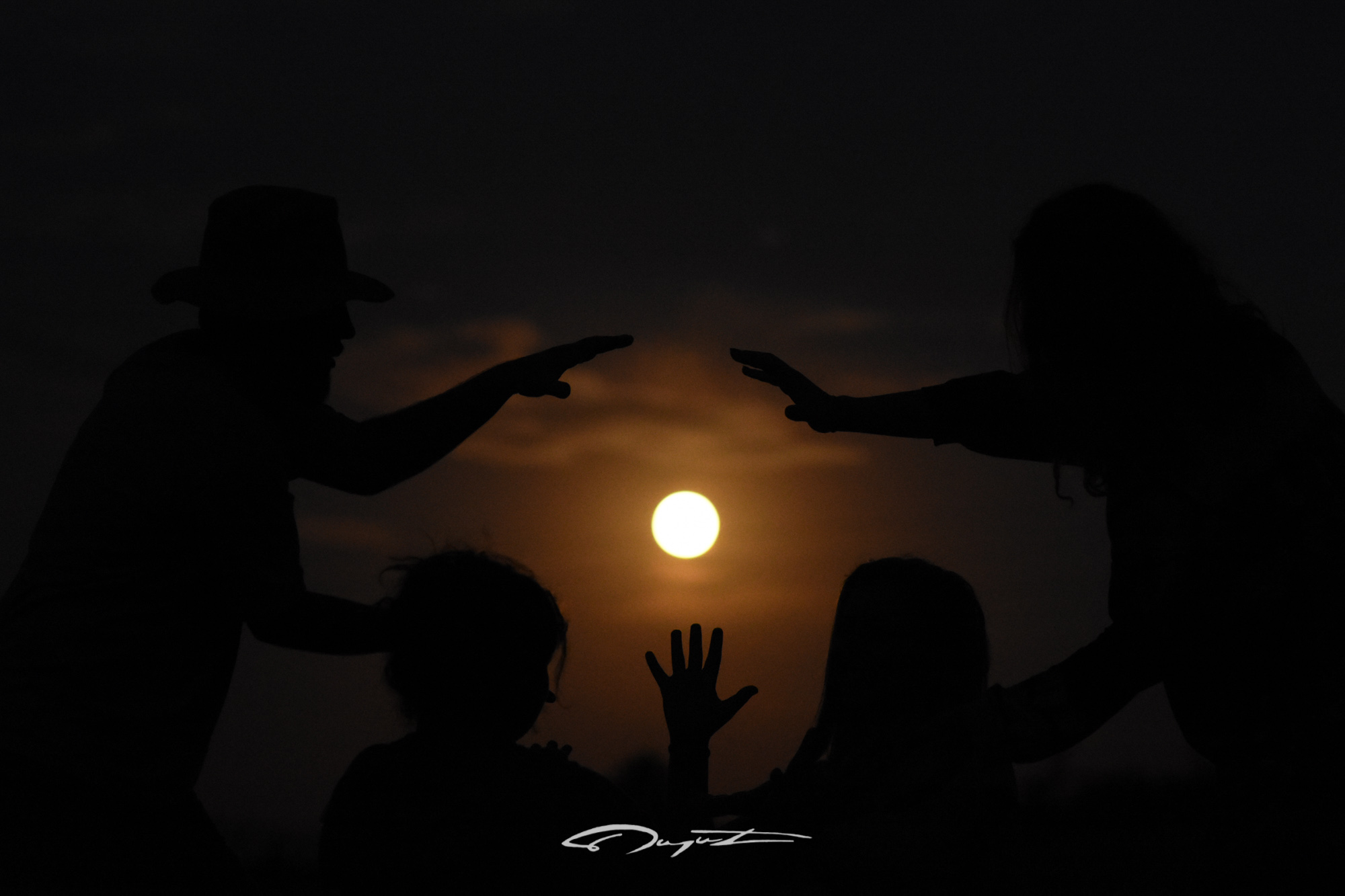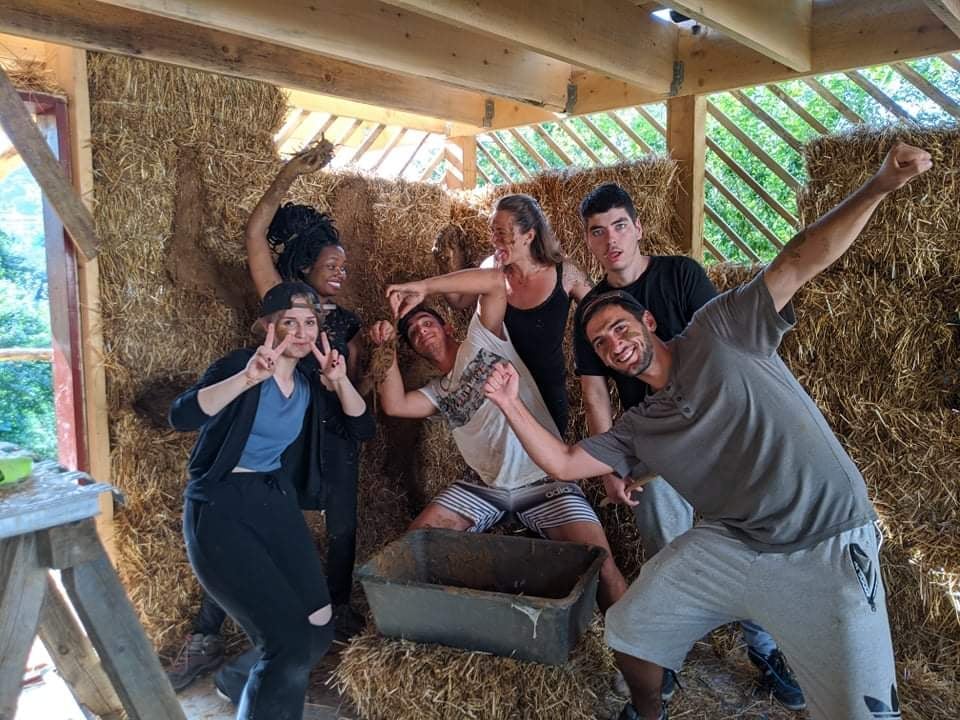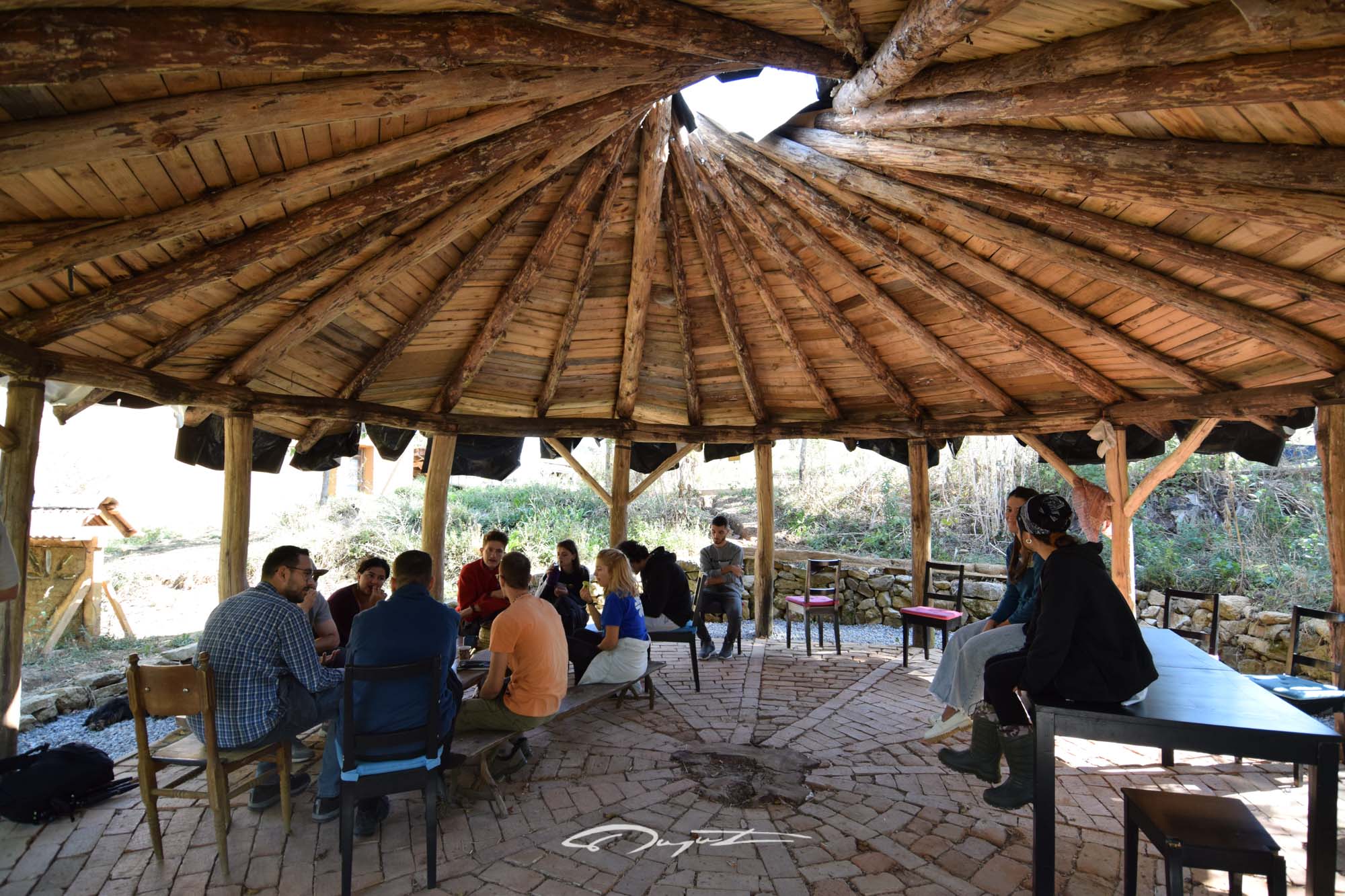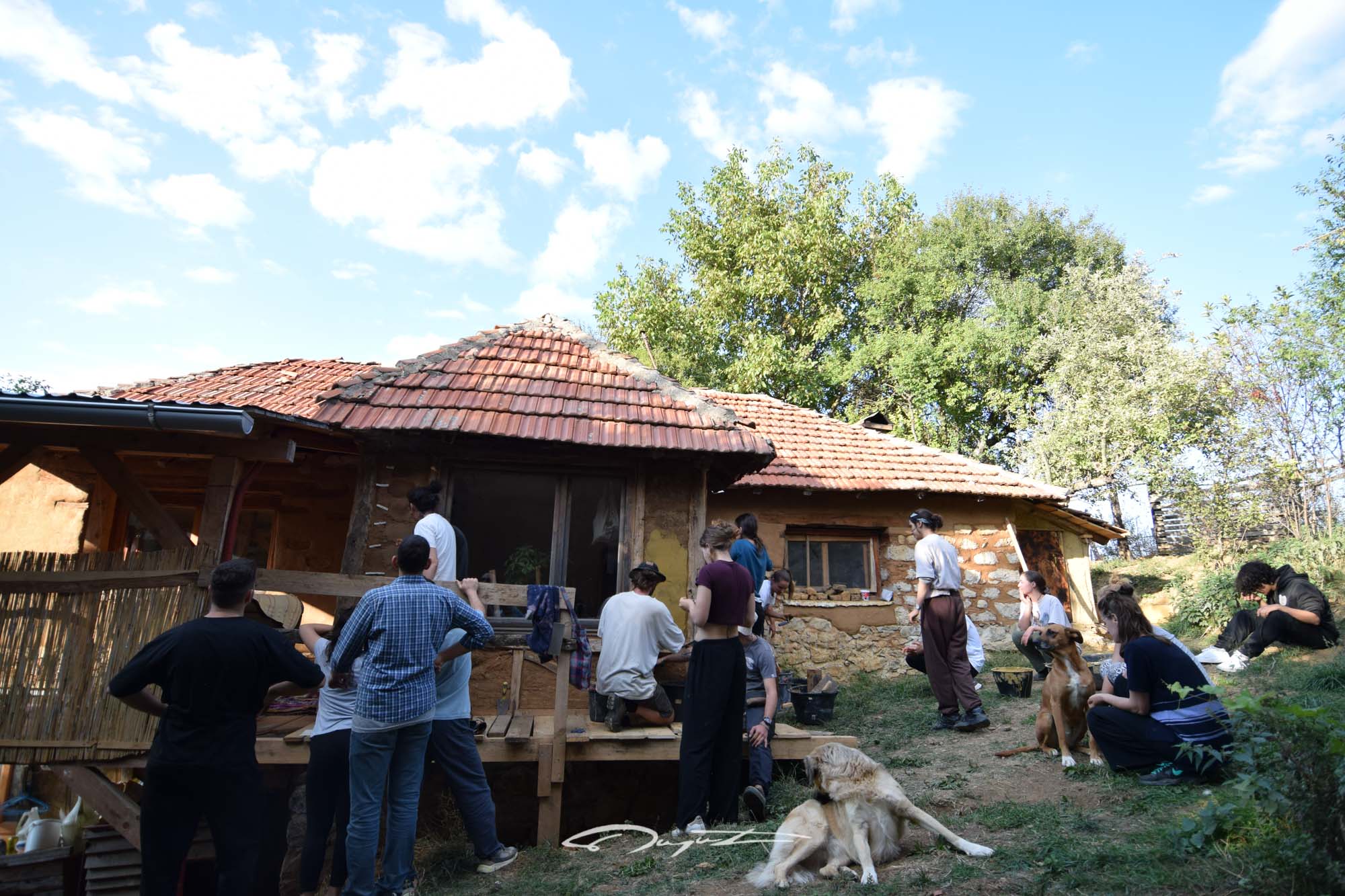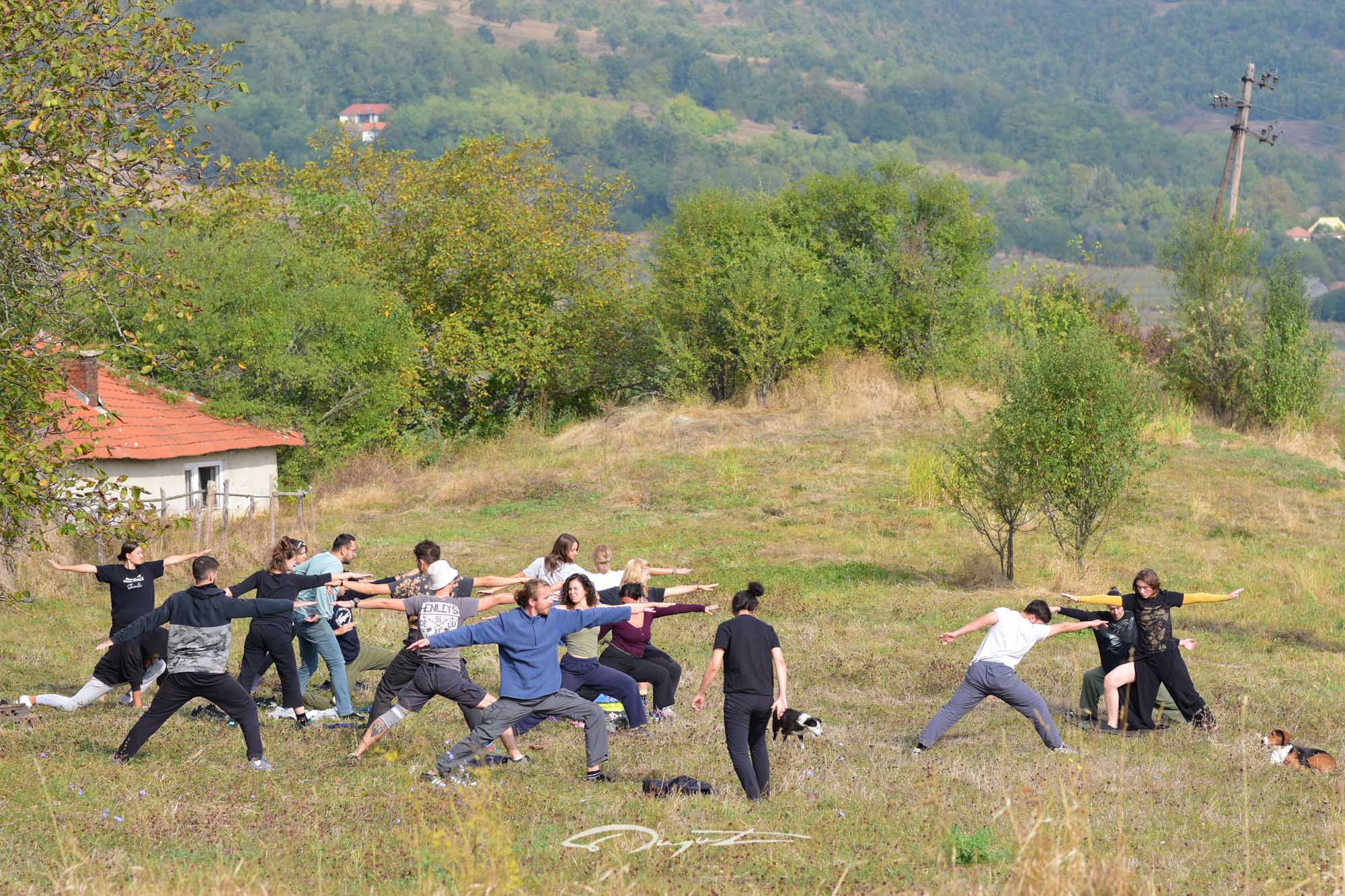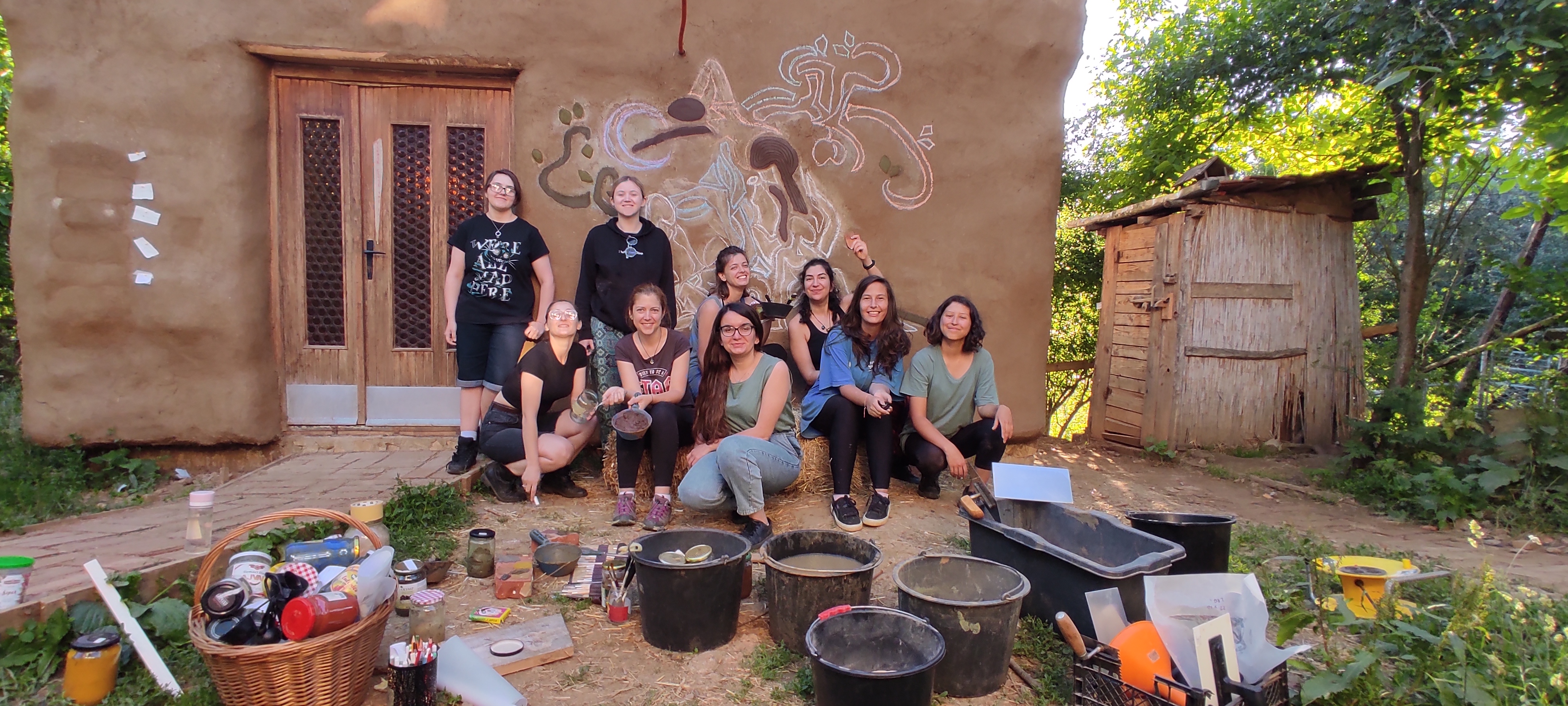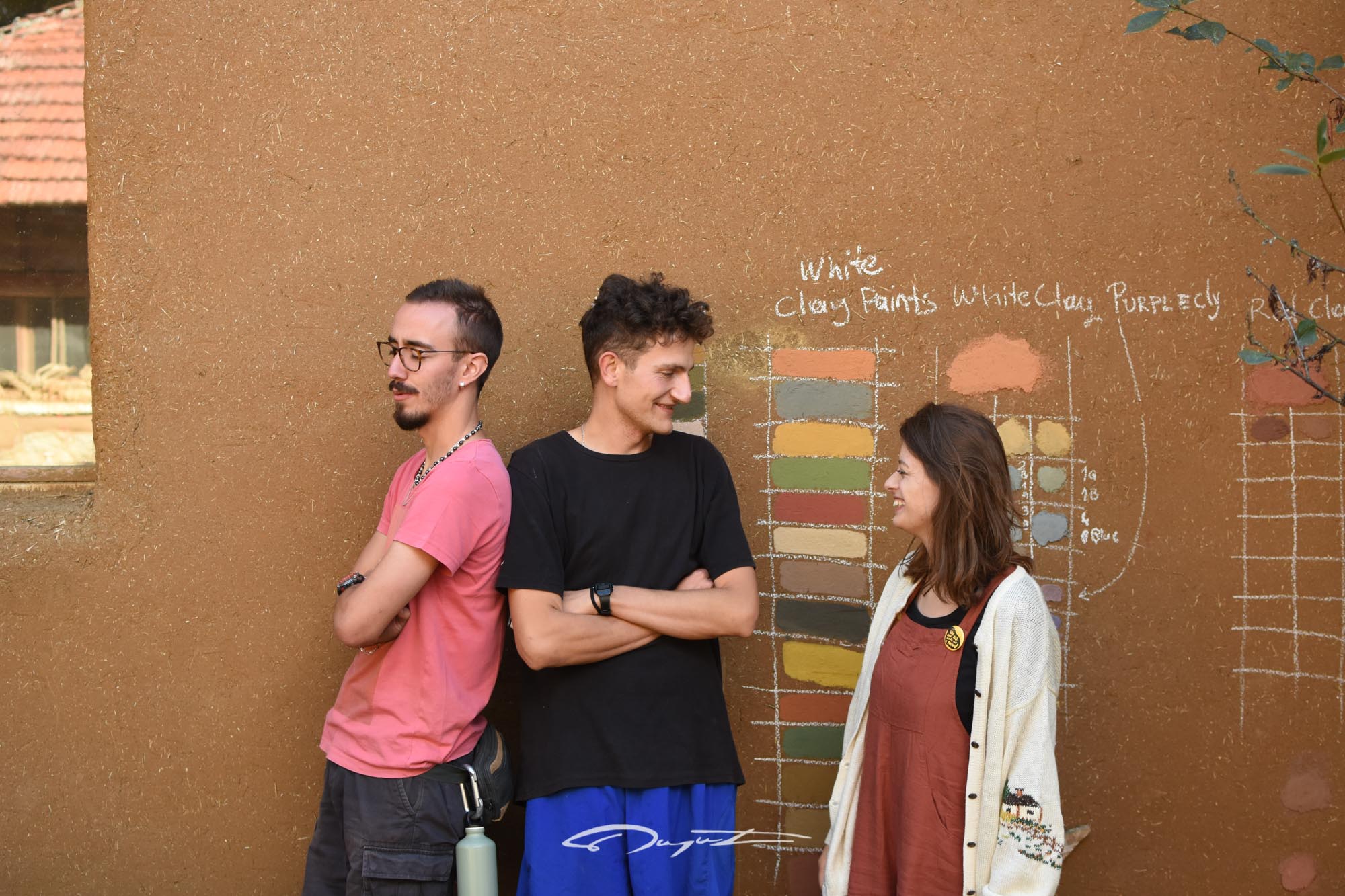Reconnecting with nature
WaaMooM
We are all Made out of Mud
The WaaMooM project is about bringing young people closer to nature through building with natural materials such as earth, straw and wood. It is also about community building, social inclusion and reconnection with tradition. WaaMooM brings people from different countries, cultures and backgrounds together through the creative art of building with nature. It provides tangible solutions for living in a healthy environment, in harmony with nature and others, while reducing the carbon footprint.
Kosovo
Local
Bozevce, Rajanovce, Ranilug
Mainly rural
It refers to other types of transformations (soft investment)
Yes
2023-11-17
Yes
Erasmus+
European Solidarity Corps
No
No
As a representative of an organisation
We are all Made out of Mud (WaaMooM) was a three-year project in the field of youth supported by the Erasmus+ program. The project combined two complementary fields: youth work and natural building. Youth work, based on a non-formal methodology of teaching, added approachability, inclusivity and additional creativity to natural building. Natural building provide unique spaces for practical hands-on experiences and for engagement in the sphere from which many modern people are alienated, unlike most of their ancestors. Non-formal approach to learning about building with natural materials opened diverse opportunities for addressing environmental challenges, social inclusion and community building. Gaining skills in natural building, but also in sharing knowledge with different target groups, empowers individuals and communities to live in healthy and nature-friendly homes.
The practice of natural building provides many possibilities for community-based work, environmental education and reconnection with tradition and nature. The practice is based on respect for the people and nature, and a balanced and sustainable lifestyle. The project provided an opportunity for GAIA to organise first training courses and youth exchanges on this topic, and to build the capacity and reputation in the field. Since 2021, GAIA has been regularly organising volunteering camps, youth exchanges and workshops on natural building, in the village of Bozevce which is known for muddy houses. This place is a unique venue in Kosovo that serves as an example and as a polygon for environmental education. The idea has spread enough to inspire others, including the local authorities who are interested in establishing an educational space for children built with natural materials only.
The practice of natural building provides many possibilities for community-based work, environmental education and reconnection with tradition and nature. The practice is based on respect for the people and nature, and a balanced and sustainable lifestyle. The project provided an opportunity for GAIA to organise first training courses and youth exchanges on this topic, and to build the capacity and reputation in the field. Since 2021, GAIA has been regularly organising volunteering camps, youth exchanges and workshops on natural building, in the village of Bozevce which is known for muddy houses. This place is a unique venue in Kosovo that serves as an example and as a polygon for environmental education. The idea has spread enough to inspire others, including the local authorities who are interested in establishing an educational space for children built with natural materials only.
Community
Village
Nature
Building
Volunteering
WaaMooM project was the crown of our growth in the field of natural building and development of activities that combine natural building with other topics, such as youth work, social inclusion, and gender related issues.
The objectives of the project included:
- Development of new methods and programs that combine youth work and natural building
- Reconnecting people with traditional techniques inspired by nature and in balance with it
- Discovering the potential of natural building to address gender equity, challenging the traditional expectation of building being mainly ‘men’s work’
- Discovering the potential of natural building to support social inclusion and empowerment of individuals through community work
- Promotion of nature-based practices, use of natural and local materials
- Practical implementation of sustainable and simple lifestyle in general
- Facilitating new connections between people using natural materials
The project serves as an example of sustainability as it deals with the area, namely the construction sector, which contributes to the global emissions of GHG in a big amount (37%). The project provides solutions for carbon neutral constructions and promotes sustainable living in all aspects of a life (housing, rational use of resources, green travel, vegetarian and vegan food, reduction of waste etc).
The objectives of the project included:
- Development of new methods and programs that combine youth work and natural building
- Reconnecting people with traditional techniques inspired by nature and in balance with it
- Discovering the potential of natural building to address gender equity, challenging the traditional expectation of building being mainly ‘men’s work’
- Discovering the potential of natural building to support social inclusion and empowerment of individuals through community work
- Promotion of nature-based practices, use of natural and local materials
- Practical implementation of sustainable and simple lifestyle in general
- Facilitating new connections between people using natural materials
The project serves as an example of sustainability as it deals with the area, namely the construction sector, which contributes to the global emissions of GHG in a big amount (37%). The project provides solutions for carbon neutral constructions and promotes sustainable living in all aspects of a life (housing, rational use of resources, green travel, vegetarian and vegan food, reduction of waste etc).
The project included different types of activities, such as youth exchanges, training courses, conference, volunteering and dissemination actions. Some of them were international, while some were organized at the local level. Some were involving just young people, such as youth exchanges and local actions, while some others were designed for youth workers and adults.
The project included different forms of designing and practical implementation of it. During the training courses, participants were able to design future activities for youth that were realized within this project, but also as part of some other projects and programs. Programs for youth exchanges, volunteer workcamps, community based programs and volunteering were developed.
We often say that natural buildings care about aesthetics and that objects made out of earth, straw, and wood are beautiful. During some of the activities designs of objects or murals were created. During youth exchanges smaller objects were constructed with earth, rammed earth and cob fire pit, clay murals, fine plastering and sgraffito earthen technique.
In the activities we respected traditional methods, in carpentry (joints, beams) and earthen building (adobe, earthen plasters, weaving, etc) and shared information and practices from different countries. The project nurtured discovering cultural heritage, tangible and intangible, and encouraged reconnection and revitalisation of its value. It serves as a reminder that traditional knowledge offers many solutions to modern problems, be it environmental or social. It also reminds us that learning from the elders and tradition should be integrated in the modern approach in dealing with global and local issues.
All in all, the project promotes nature friendly practices in building, that combine tradition and modern approach, care for the planet and care for people.
The project included different forms of designing and practical implementation of it. During the training courses, participants were able to design future activities for youth that were realized within this project, but also as part of some other projects and programs. Programs for youth exchanges, volunteer workcamps, community based programs and volunteering were developed.
We often say that natural buildings care about aesthetics and that objects made out of earth, straw, and wood are beautiful. During some of the activities designs of objects or murals were created. During youth exchanges smaller objects were constructed with earth, rammed earth and cob fire pit, clay murals, fine plastering and sgraffito earthen technique.
In the activities we respected traditional methods, in carpentry (joints, beams) and earthen building (adobe, earthen plasters, weaving, etc) and shared information and practices from different countries. The project nurtured discovering cultural heritage, tangible and intangible, and encouraged reconnection and revitalisation of its value. It serves as a reminder that traditional knowledge offers many solutions to modern problems, be it environmental or social. It also reminds us that learning from the elders and tradition should be integrated in the modern approach in dealing with global and local issues.
All in all, the project promotes nature friendly practices in building, that combine tradition and modern approach, care for the planet and care for people.
Natural building is an inclusive practice and can be designed for specific groups, with specific obstacles, challenges or impairment. Combined with youth work, natural building becomes a tool for dealing with different social issues. Activities can be adjusted to different tempo, they can be experiments, demonstrative, with or without specific goal. There are many different parts of building practices, where individuals with different skills can join. Even children can take part in them. Even though we are aware that building requires training, skills and precision; also a high level of safety we also believe that those activities can happen within easier stages of building any object, or small object: plasters, furniture, decoration…
These activities can bring people and communities together and at the same time help someone in building their home. Natural building revives practices of the past, where neighbours used to help each other build their homes. It can help people with economic difficulties and people in need of shelter. Some objects could be temporary, some permanent. Construction of the object in Turkey, as part of the local actions, was an example of solidarity and inclusion of those who needed a community space after the devastating earthquake.
Working with earth has therapeutic effects. Being in contact with the earth awakens senses that were forgotten. It brings people close to the present and close to nature. Building a house of earth is an art of its own.
These activities can bring people and communities together and at the same time help someone in building their home. Natural building revives practices of the past, where neighbours used to help each other build their homes. It can help people with economic difficulties and people in need of shelter. Some objects could be temporary, some permanent. Construction of the object in Turkey, as part of the local actions, was an example of solidarity and inclusion of those who needed a community space after the devastating earthquake.
Working with earth has therapeutic effects. Being in contact with the earth awakens senses that were forgotten. It brings people close to the present and close to nature. Building a house of earth is an art of its own.
10 organisations from 9 European countries (Albania, Bosnia and Herzegovina, Croatia, Serbia, Montenegro, Kosovo, Slovenia, France, Turkey) were directly involved in this project. Many other organisations and institutions were involved through local activities, study visits and the final conference. The partner organizations benefited from knowledge exchange and collaborative growth through support and merging of approaches. Through collaborative work, the partner organizations developed materials (handbook and quality standards) and safety guidelines that are used in their work with youth in the field of natural building. The same guidelines are available for free use for any organisations that combine these two fields.
Most of the organizations continued collaborating in this field and organized regional and international events in the field of natural building, spreading the solutions, ideas and values around it.
Citizens and local communities benefited from the revitalisation of traditional techniques, memories and ideas for healthier ways of constructing objects for living. The communities in which activities of the project took place could benefit from better recognition in the field of nature-based practices and international youth work.
Most of the organizations continued collaborating in this field and organized regional and international events in the field of natural building, spreading the solutions, ideas and values around it.
Citizens and local communities benefited from the revitalisation of traditional techniques, memories and ideas for healthier ways of constructing objects for living. The communities in which activities of the project took place could benefit from better recognition in the field of nature-based practices and international youth work.
As mentioned above, 10 organizations were involved in the project. The level of engagement in the project design was different. However, the main objectives and the concept were agreed upon by all. We shall take into account that the project was developed just before the pandemic Covid-19 broke out worldwide. The beginning of the project was jeopardized with it and certain adjustments had to take place.
Each of the partners has contributed to the project with their expertise. For instance, KFZ from Serbia could introduce ECVET certification to some of the events during the project. Bugday from Turkey was involved in disaster relief activities after the earthquake and their actions added a strong solidarity aspect to the project. Some participants shared their involvement in projects that combine work with refugees and natural building or women empowerment. Through study visits, we could learn about different good examples of natural building and community-based projects in Slovenia and Croatia.
Each of the partners has contributed to the project with their expertise. For instance, KFZ from Serbia could introduce ECVET certification to some of the events during the project. Bugday from Turkey was involved in disaster relief activities after the earthquake and their actions added a strong solidarity aspect to the project. Some participants shared their involvement in projects that combine work with refugees and natural building or women empowerment. Through study visits, we could learn about different good examples of natural building and community-based projects in Slovenia and Croatia.
On a basic level, we can say that the project combines two fields: youth work and natural building. However, the project also tackled many other fields such as social inclusion, community building, gender issues, environmental protection, reconciliation in the Western Balkans etc.
The participants could learn about:
- How to organize volunteering projects about natural building
- How to prepare and organise youth exchanges about natural building
- Basics of youth work, group dynamics, safety and non-formal learning
- History of natural building and its role in combating climate change
- How to work with hand tools
- How to use earth, straw, and wood in building
- How to work with different forms of earthen materials
- How to test earth to make sure it is safe for building
- How to make murals with natural pigments and sgraffito
- How to adjust to different global and local circumstances
The representatives of different fields interacted in a professional, open-minded and inclusive way. Through meetings, the representatives would agree on a common approach and important principles. Thanks to the quality standards and safety guidelines, the main framework for the activities was already set up.
The participants could learn about:
- How to organize volunteering projects about natural building
- How to prepare and organise youth exchanges about natural building
- Basics of youth work, group dynamics, safety and non-formal learning
- History of natural building and its role in combating climate change
- How to work with hand tools
- How to use earth, straw, and wood in building
- How to work with different forms of earthen materials
- How to test earth to make sure it is safe for building
- How to make murals with natural pigments and sgraffito
- How to adjust to different global and local circumstances
The representatives of different fields interacted in a professional, open-minded and inclusive way. Through meetings, the representatives would agree on a common approach and important principles. Thanks to the quality standards and safety guidelines, the main framework for the activities was already set up.
The innovative character of the project is seen in two aspects:
1. The combination of youth work and non-formal learning with natural building (construction), which was so far never deepened in that way, combining working meetings, implementation and monitoring;
2. The use of the natural building as a tool for social inclusion, gender-related issues and finally reconnection and reconciliation.
The majority of events around the natural building are professional courses that require a certain fee that most young people cannot afford. Most of such events are not adjusted to the learners' needs, but they follow specific curriculum and set up objectives. They are not open to all, and often they are rather exclusive.
Our project, on the contrary, was open for all, because the activities were adjusted to the needs of the participants, being young people or youth workers. The objectives of the project were not only to learn about natural building but to discover its potential in other spheres, in particular, related to social and environmental issues. The methodology used was learner-centred and based on non-formal tools for learning and team building.
In most of the mainstream activities and courses, men are the main organisers and facilitators. Our activities were mainly coordinated and facilitated by women, with the support of men. Such an approach in the field which is seen as predominantly male field, is innovative and unusual.
1. The combination of youth work and non-formal learning with natural building (construction), which was so far never deepened in that way, combining working meetings, implementation and monitoring;
2. The use of the natural building as a tool for social inclusion, gender-related issues and finally reconnection and reconciliation.
The majority of events around the natural building are professional courses that require a certain fee that most young people cannot afford. Most of such events are not adjusted to the learners' needs, but they follow specific curriculum and set up objectives. They are not open to all, and often they are rather exclusive.
Our project, on the contrary, was open for all, because the activities were adjusted to the needs of the participants, being young people or youth workers. The objectives of the project were not only to learn about natural building but to discover its potential in other spheres, in particular, related to social and environmental issues. The methodology used was learner-centred and based on non-formal tools for learning and team building.
In most of the mainstream activities and courses, men are the main organisers and facilitators. Our activities were mainly coordinated and facilitated by women, with the support of men. Such an approach in the field which is seen as predominantly male field, is innovative and unusual.
The project flow consisted of meetings, capacity building and mobility activities. Project meetings included (1) Preparation, (2) Midterm evaluation and (3) Final evaluation. Capacity-building activities covered Local dissemination actions (Turkey, Serbia, Kosovo and Albania), a Conference in Serbia, the production of materials, a website, a film and a detailed and comprehensive evaluation.
The 1st training for organising international groups on natural building provided knowledge, experience and skills for youth leaders to prepare the two youth exchanges within the project. The first youth exchange on natural building and gender equity, was a great success in terms of program, team building, learning, practical part, bringing the topic of gender out and fun. After the first exchange, a midterm evaluation meeting took place, where group reflection and evaluation were organised, as well as detailed planning of the second part of the project. This included preparation of the 2nd training, 2nd exchange, local actions and Conference. The only volunteer that took part in the project in 2021, supported GAIA in the development of the programs on natural building for youth, preparation of events, mapping of existing practices and defining standards for volunteering. The 2nd training provided fundamental knowledge, skills and competencies for future coordinators of volunteers in natural building. Local actions supported the organisation to realise activities (with Roma youth in Kosovo, the post-disaster area in Turkey, with women in Serbia, with youth in Albania) with local youth and youth workers, using gained knowledge and experience throughout the project. The final Conference brought together participants from different activities of the project, as well as experts from the fields of youth work, natural building, and social enterprises. It was the crown of the project, as it served as a platform for exchange, sharing, learning, ideas, connections and celebration.
The 1st training for organising international groups on natural building provided knowledge, experience and skills for youth leaders to prepare the two youth exchanges within the project. The first youth exchange on natural building and gender equity, was a great success in terms of program, team building, learning, practical part, bringing the topic of gender out and fun. After the first exchange, a midterm evaluation meeting took place, where group reflection and evaluation were organised, as well as detailed planning of the second part of the project. This included preparation of the 2nd training, 2nd exchange, local actions and Conference. The only volunteer that took part in the project in 2021, supported GAIA in the development of the programs on natural building for youth, preparation of events, mapping of existing practices and defining standards for volunteering. The 2nd training provided fundamental knowledge, skills and competencies for future coordinators of volunteers in natural building. Local actions supported the organisation to realise activities (with Roma youth in Kosovo, the post-disaster area in Turkey, with women in Serbia, with youth in Albania) with local youth and youth workers, using gained knowledge and experience throughout the project. The final Conference brought together participants from different activities of the project, as well as experts from the fields of youth work, natural building, and social enterprises. It was the crown of the project, as it served as a platform for exchange, sharing, learning, ideas, connections and celebration.
The project can fully or in parts be replicated to other places and organisations. The whole idea of it was to build the capacity of the organizations to organise different types of educational and volunteering activities on this topic. This is the reason why a handbook with background information, templates for activities and quality standards was developed. Besides that, the project produced safety guidelines which provide necessary information about this aspect for different types of activities.
For instance, international camps (ESC volunteering teams and scout camps) on natural building based on the outcomes of the project were already realised in Kosovo. Local organisations from Serbia and Turkey have been planning to realise similar activities in their communities. Some of the organisations are also hosting long-term volunteers that are involved in natural building activities. The documentary has been screened at several regional events and festivals.
Taking into account the flexibility and adaptability of non-formal learning and methodology, the activities of the project can be adjusted to different contexts. One of the training courses was also adjusted and implemented in Jordan, where the context and climate differ from the Balkans.
Moreover, together with the partners, the follow-up project ideas were submitted to some of the donors and an upgraded version of WaaMooM 2.0 will be submitted to Erasmus+.
For instance, international camps (ESC volunteering teams and scout camps) on natural building based on the outcomes of the project were already realised in Kosovo. Local organisations from Serbia and Turkey have been planning to realise similar activities in their communities. Some of the organisations are also hosting long-term volunteers that are involved in natural building activities. The documentary has been screened at several regional events and festivals.
Taking into account the flexibility and adaptability of non-formal learning and methodology, the activities of the project can be adjusted to different contexts. One of the training courses was also adjusted and implemented in Jordan, where the context and climate differ from the Balkans.
Moreover, together with the partners, the follow-up project ideas were submitted to some of the donors and an upgraded version of WaaMooM 2.0 will be submitted to Erasmus+.
The project responded to the environmental issues and climate crisis. As mentioned above, construction sectors contribute to the global emission of GHG with 37%. Alternative nature-based solutions are imperative for all sectors. Luckily, there are already many available options that should be implemented and promoted. Building with natural materials can be one of the major solutions, if given a chance. Natural materials, such as straw or hemp, provide healthy and carbon negative insulation options. In some countries it is already widely used. Use of locally grown materials reduces emissions caused by transportations. Earthen plasters allow houses to breathe without the use of any mechanical device, but through passive properties of clay and its inhabitants to be surrounded with a healthy environment in energy efficient houses. If built properly, natural homes do not need air conditioning and they require much less energy for heating in winter. Finally, these kinds of homes are biodegradable and they do not leave non recyclable waste or microplastic. They are tangible solutions for the environmental crisis. Not only natural houses are healthy and safe for homeowners but they are also much safer for builders to build
The project empowered individuals and organisations to dive deeper into natural bulidng and to continue developing programs and activities in the field. By providing local solutions for individuals and communities, the project directly answers to the global challenges of climate change.
The project empowered individuals and organisations to dive deeper into natural bulidng and to continue developing programs and activities in the field. By providing local solutions for individuals and communities, the project directly answers to the global challenges of climate change.
During the project, participants experienced beauty and potential in natural building in working with youth, social inclusion, gender issues, prejudices, stereotypes, empowerment and personal development. Some of the participants have decided to focus in this field as professional builders, carpenters or youth workers who use natural building as a tool.
All of the participants learned about the practical aspects of sustainability and the advantages of a rural lifestyle. They learned and became more aware of the impact of aviation and its alternatives to it. They learned about everyday sustainability through energy efficiency, rational use of water, composting toilets, a vegetarian diet based on local products, the benefits of natural homes and much more. They also learn how to be more connected to their peers, due to the limited amount and coverage of WiFi networks in our programs. With raised awareness and increased knowledge of sustainability, the participants became promoters of practical solutions for sustainability, inclusion and gender equity.
Through working with hands and natural materials, the participants got in contact with the essence of nature - earth. They were in direct connection with the earth from which they could make homes and art. Through this, they could reassess their relation to nature, others, themselves and life in general. Working with earth, and building with earth is a true example of our reconnection with nature.
All of the participants learned about the practical aspects of sustainability and the advantages of a rural lifestyle. They learned and became more aware of the impact of aviation and its alternatives to it. They learned about everyday sustainability through energy efficiency, rational use of water, composting toilets, a vegetarian diet based on local products, the benefits of natural homes and much more. They also learn how to be more connected to their peers, due to the limited amount and coverage of WiFi networks in our programs. With raised awareness and increased knowledge of sustainability, the participants became promoters of practical solutions for sustainability, inclusion and gender equity.
Through working with hands and natural materials, the participants got in contact with the essence of nature - earth. They were in direct connection with the earth from which they could make homes and art. Through this, they could reassess their relation to nature, others, themselves and life in general. Working with earth, and building with earth is a true example of our reconnection with nature.

